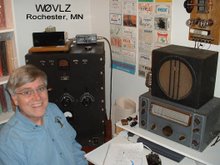The easiest issue to address is the high filament voltage. I measured it to be about 10% high. This makes sense. In 1940 house current was lower than today, about 110 V vs 120-125 V today. A power transformer designed to generate 6.3 V in 1940 wold now show closer to 7 V, about what I measured. To solve this I have step down transformers at both of my prewar operating positions. I decided to add a third.
I started with a 12V at 8A filament transformer that I had on the shelf and rewired it with the primary and secondary windings in series. With the windings properly polarized 120V across both windings generates 108 V at the junction of the two windings. It becomes an auto-transformer with one tap. Since only the old 12 V winding sees full current, the 8 A rating now is the auto-transformer rating, about 900 watts. Electrically this auto-transformer sits between the 120 V wall outlet and the 10P. The 900 W power rating will allow me to plug my receiver, probably a NC-81X, into it also.
As expected the 10P filament voltage dropped to 6.3 V but B+ still remains high. This may be because the replacement electrolytics I used in the power supply are larger than the originals. I'll need to work on this.
Addendum - The high B+ was a simple fix (but I'm not a fan of the engineering trade off behind it). I had removed the 6L6 modulator while testing CW. It turns out that this tube loads down the power supply, even in CW mode. I plugged the 6L6 modulator in and B+ now looks about right.


No comments:
Post a Comment